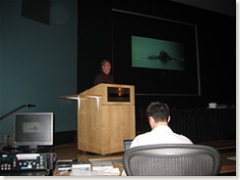 Day two started with Scott Niesen talking about Putting Web Feeds to Work.
Day two started with Scott Niesen talking about Putting Web Feeds to Work.
The program suggested that I’d learn “how RSS and ATOM web feeds can be used to effectively monitor your company’s reputation, automatically track competitors and industry trends impacting your business, and make project team communication more efficient.”
Unfortunately (in my view), Scott’s presentation sounded way too much as a sale pitch for Attensa. I’m sure it’s a good tool. But at a conference like this that I paid thousands of dollars to travel to and attend, I don’t really appreciate blatant sales pitches masquerading as a presentation.
Having said that, Scott did provide a good overview of uses of RSS feeds in a corporate environment.
Scott started looking at the needs of different audiences:
- IT: needs to get the right information to the right place at the right time
- Consumers: need to get the right information while managing information overload
Webfeeds are the perfect tools for both of those needs.
Webfeeds have entered the workplace largely through the back door – through the efforts of employee bloggers. Now, like other tools that started in the consumer space, RSS feeds are beginning to find their way into the corporate environment.
Stages of RSS entry into the business environment:
- blog posts, news headlines to monitor the world
- business intelligence alerts for more specific information relating to the company
- internal blogs and wikis enable collaboration
- RSS-enabled enterprise apps to connect legacy IT information systems
The number one benefit of putting webfeeds to work is their use as an indispensable research tool. They can provide competitive intelligence. Scott’s company, Attensa, has been purpose built as a corporate tool for this purpose – tapping into 18 information sources, including google and the other search tools.
Feeds can also be used to monitor reputation, track buzz relating to markets, trends and people. Because bloggers tend to post frequently and quickly, they can also act as an early warning system, as news may break in the blogosphere long before it shows up on mainstream media.
Feeds can also support collaboration. The persistence of the information ensures that institutional memory is maintained in a searchable form. Subscriptions ease and speed information distribution. The delivery of information directly to interested users to be used when they are ready for it helps all team members stay abreast of developments. And the broad distribution of feeds behind the firewall can be used to build shared vision. Finally, all of this information taken together should provide the data for new insights.
Feeds can also be viewed as an indispensable delivery tool for training material, including podcasts, audio and video. Information can be delivered to a dispersed work force regarding sales leads, forecasts and opportunities.
RSS Feeds can also be used to support searching for information through indexing and tagging.
